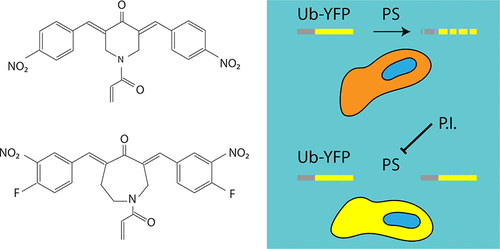当前位置:
X-MOL 学术
›
J. Med. Chem.
›
论文详情
Our official English website, www.x-mol.net, welcomes your
feedback! (Note: you will need to create a separate account there.)
Dienone Compounds: Targets and Pharmacological Responses
Journal of Medicinal Chemistry ( IF 6.8 ) Pub Date : 2020-11-04 , DOI: 10.1021/acs.jmedchem.0c00812 Martina Bazzaro 1 , Stig Linder 2, 3
Journal of Medicinal Chemistry ( IF 6.8 ) Pub Date : 2020-11-04 , DOI: 10.1021/acs.jmedchem.0c00812 Martina Bazzaro 1 , Stig Linder 2, 3
Affiliation

|
The biological responses to dienone compounds with a 1,5-diaryl-3-oxo-1,4-pentadienyl pharmacophore have been studied extensively. Despite their expected general thiol reactivity, these compounds display considerable degrees of tumor cell selectivity. Here we review in vitro and preclinical studies of dienone compounds including b-AP15, VLX1570, RA-9, RA-190, EF24, HO-3867, and MCB-613. A common property of these compounds is their targeting of the ubiquitin–proteasome system (UPS), known to be essential for the viability of tumor cells. Gene expression profiling experiments have shown induction of responses characteristic of UPS inhibition, and experiments using cellular reporter proteins have shown that proteasome inhibition is associated with cell death. Other mechanisms of action such as reactivation of mutant p53, stimulation of steroid receptor coactivators, and induction of protein cross-linking have also been described. Although unsuitable as biological probes due to widespread reactivity, dienone compounds are cytotoxic to apoptosis-resistant tumor cells and show activity in animal tumor models.
中文翻译:

二烯酮化合物:靶标和药理反应
已经广泛研究了对具有1,5-二芳基-3-氧代-1,4-戊二烯基药效基团的二烯酮化合物的生物反应。尽管预期它们具有一般的硫醇反应性,但这些化合物仍显示出相当程度的肿瘤细胞选择性。在这里我们体外审查以及包括b-AP15,VLX1570,RA-9,RA-190,EF24,HO-3867和MCB-613在内的二烯酮化合物的临床前研究。这些化合物的共同特性是它们靶向遍在蛋白-蛋白酶体系统(UPS),这对于肿瘤细胞的生存至关重要。基因表达谱实验表明诱导了UPS抑制特性应答,而使用细胞报道蛋白的实验表明蛋白酶体抑制与细胞死亡有关。还已经描述了其他作用机制,例如突变体p53的重新激活,类固醇受体共激活剂的刺激以及蛋白交联的诱导。尽管由于广泛的反应性而不适合用作生物学探针,但是二烯酮化合物对抗凋亡的肿瘤细胞具有细胞毒性,并且在动物肿瘤模型中显示出活性。
更新日期:2020-12-24
中文翻译:

二烯酮化合物:靶标和药理反应
已经广泛研究了对具有1,5-二芳基-3-氧代-1,4-戊二烯基药效基团的二烯酮化合物的生物反应。尽管预期它们具有一般的硫醇反应性,但这些化合物仍显示出相当程度的肿瘤细胞选择性。在这里我们体外审查以及包括b-AP15,VLX1570,RA-9,RA-190,EF24,HO-3867和MCB-613在内的二烯酮化合物的临床前研究。这些化合物的共同特性是它们靶向遍在蛋白-蛋白酶体系统(UPS),这对于肿瘤细胞的生存至关重要。基因表达谱实验表明诱导了UPS抑制特性应答,而使用细胞报道蛋白的实验表明蛋白酶体抑制与细胞死亡有关。还已经描述了其他作用机制,例如突变体p53的重新激活,类固醇受体共激活剂的刺激以及蛋白交联的诱导。尽管由于广泛的反应性而不适合用作生物学探针,但是二烯酮化合物对抗凋亡的肿瘤细胞具有细胞毒性,并且在动物肿瘤模型中显示出活性。






























 京公网安备 11010802027423号
京公网安备 11010802027423号